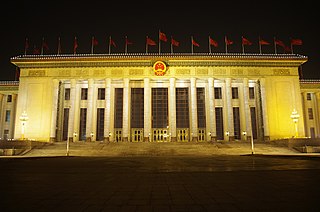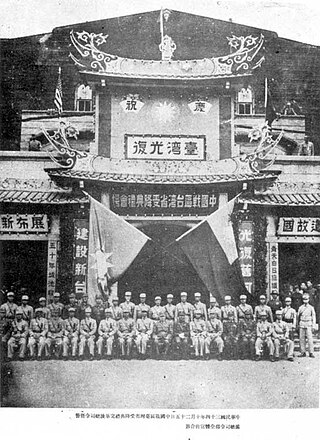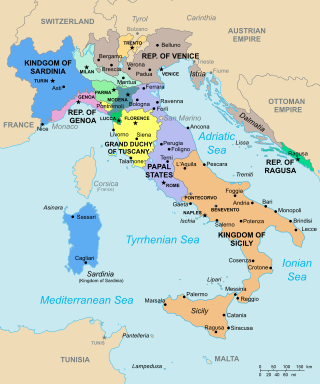
The Louisiana Purchase was the acquisition of the territory of Louisiana by the United States from the French First Republic in 1803. This consisted of most of the land in the Mississippi River's drainage basin west of the river. In return for fifteen million dollars, or approximately eighteen dollars per square mile, the United States nominally acquired a total of 828,000 sq mi in Middle America. However, France only controlled a small fraction of this area, most of which was inhabited by Native Americans; effectively, for the majority of the area, the United States bought the preemptive right to obtain Indian lands by treaty or by conquest, to the exclusion of other colonial powers.

The Treaty of Nanking was an unequal treaty between Great Britain and the Qing dynasty of China to end the First Opium War (1839–1842), signed on 29 August 1842.

The Treaty of Shimonoseki, also known as the Treaty of Maguan in China and Treaty of Bakan in the period before and during World War II in Japan, was an unequal treaty signed at the Shunpanrō hotel, Shimonoseki, Japan on April 17, 1895, between the Empire of Japan and Qing China, ending the First Sino-Japanese War.
The controversy surrounding the political status of Taiwan or the Taiwan issue is an ongoing dispute on the political status of Taiwan, currently controlled by the Republic of China (ROC). This dispute arose in the mid-twentieth century.

The Sino-British Joint Declaration was a treaty between the governments of the United Kingdom and China signed in 1984 setting the conditions in which Hong Kong was transferred to Chinese control and for the governance of the territory after 1 July 1997.

The Convention of Peking or First Convention of Peking is an agreement comprising three distinct unequal treaties concluded between the Qing dynasty of China and Great Britain, France, and the Russian Empire in 1860.

The Mexican Cession is the region in the modern-day western United States that Mexico previously controlled, then ceded to the United States in the Treaty of Guadalupe Hidalgo in 1848 after the Mexican–American War. This region had not been part of the areas east of the Rio Grande that had been claimed by the Republic of Texas, though the Texas annexation resolution two years earlier had not specified the southern and western boundary of the new state of Texas. At roughly 529,000 square miles (1,370,000 km2), not including any Texas lands, the Mexican Cession was the third-largest acquisition of territory in U.S. history, surpassed only by the 827,000-square-mile (2,140,000 km2) Louisiana Purchase and the 586,000-square-mile (1,520,000 km2) Alaska Purchase.

The territory of the United States and its overseas possessions has evolved over time, from the colonial era to the present day. It includes formally organized territories, proposed and failed states, unrecognized breakaway states, international and interstate purchases, cessions, and land grants, and historical military departments and administrative districts. The last section lists informal regions from American vernacular geography known by popular nicknames and linked by geographical, cultural, or economic similarities, some of which are still in use today.

Reinsurance is insurance that an insurance company purchases from another insurance company to insulate itself from the risk of a major claims event. With reinsurance, the company passes on ("cedes") some part of its own insurance liabilities to the other insurance company. The company that purchases the reinsurance policy is referred to as the "ceding company" or "cedent". The company issuing the reinsurance policy is referred to as the "reinsurer". In the classic case, reinsurance allows insurance companies to remain solvent after major claims events, such as major disasters like hurricanes or wildfires. In addition to its basic role in risk management, reinsurance is sometimes used to reduce the ceding company's capital requirements, or for tax mitigation or other purposes.

The Sino-Japanese Peace Treaty, formally the Treaty of Peace between the Republic of China and Japan and commonly known as the Treaty of Taipei, was a peace treaty between Japan and the Republic of China (ROC) signed in Taipei, Taiwan on 28 April 1952, and took effect on August 5 the same year, marking the formal end of the Second Sino-Japanese War (1937–1945).

The state cessions are those areas of the United States that the separate states ceded to the federal government in the late 18th and early 19th centuries. The cession of these lands, which for the most part lay between the Appalachian Mountains and the Mississippi River, was key to establishing a harmonious union among the former British colonies.

The West Florida Controversy included two border disputes that involved Spain and the United States in relation to the region known as West Florida over a period of 37 years. The first dispute commenced immediately after Spain received the colonies of West and East Florida from the Kingdom of Great Britain following the American Revolutionary War. Initial disagreements were settled with Pinckney's Treaty of 1795.

Retrocession Day is the name given to the annual observance and a former public holiday in Taiwan to commemorate the end of Japanese rule of Taiwan and Penghu, and the claimed retrocession ("return") of Taiwan to the Republic of China on 25 October 1945. However, the idea of "Taiwan retrocession" is in dispute.

The Convention between the United Kingdom and China, Respecting an Extension of Hong Kong Territory, commonly known as the Convention for the Extension of Hong Kong Territory or the Second Convention of Peking, was a lease and unequal treaty signed between Qing China and the United Kingdom in Peking on 9 June 1898, leasing to the United Kingdom for 99 years, at no charge, the New Territories and northern Kowloon, including 235 islands.

The Treaty of Aranjuez (1801) was signed on 21 March 1801 between France and Spain. It confirmed a previous secret agreement in which Spain agreed to exchange Louisiana for territories in Tuscany. The treaty also stipulated Spain's cession of Louisiana to be a "restoration", not a retrocession.

The Sino-Portuguese Treaty of Peking was a trade unequal treaty between the Kingdom of Portugal and the Qing dynasty of China, signed on 1 December 1887. It is counted by the Chinese as among the unequal treaties in the aftermath of the Second Opium War. The treaty gave Portugal perpetual colonial rights to Macau on the condition that Portugal would cooperate in efforts to end the smuggling of opium.
A number of methods of acquisition of sovereignty are or have been recognised by international law as lawful methods by which a state may acquire sovereignty over territory. International law adopts much of Roman property law in regards to acquisition of sovereignty due to the underlying European civil law at the time of early discovery voyages such as Christopher Columbus. The basis of acquisition of states ownership of vacant territory therefore continues to apply,.

The "century of humiliation" is a term used among the Sinosphere to describe the period in Chinese history beginning with the First Opium War (1839–1842), and ending in 1945 with China emerging out of the Second World War as one of the Big Four and established as a permanent member of the United Nations Security Council, or alternately, ending in 1949 with the founding of the People's Republic of China. The century-long period is typified by the decline, defeat and political fragmentation of the Qing dynasty and the subsequent Republic of China, which led to demoralizing foreign intervention, annexation and subjugation of China by Western powers, Russia, and Japan.

The territorial conquests of the Empire of Japan in the Western Pacific Ocean and East Asia began in 1895 with its victory over Qing China in the First Sino-Japanese War. Subsequent victories over the Russian Empire and German Empire expanded Japanese rule to Taiwan, Korea, Micronesia, southern Sakhalin, several concessions in China, and the South Manchuria Railway. In 1931, Japan invaded Manchuria, resulting in the establishment of the puppet state of Manchukuo the following year; thereafter, Japan adopted a policy of founding and supporting puppet states in conquered regions. These conquered territories became the basis for the Greater East Asia Co-Prosperity Sphere in 1940.
















